A Mathematical Analysis of the Stress Statement of the Soil Basis under Complex Loading near the Retaining Wall
Abstract
:1. Introduction
2. Materials and Methods
3. Results
4. Discussion
5. Conclusions
- It follows from the analysis of the results of the accurate mathematical solution to the problem that supplementary horizontal and vertical stresses in the range of 10–30 kPa arise on the y axis in the absence of horizontal displacements. At x = 0, shear stresses τxy = 0;
- Based on a comparative analysis of the obtained solution to the problem of stress distribution in an array of soils with finite widths and thicknesses based on an incompressible base, using the method of the Ribiere–Fileon trigonometric series and the solution obtained in the PLAXIS 2D software, it was shown that the actual behaviour of soil bases under a load, in particular at a distance from the side of the pit, corresponded closely to the model of soil basis, which allows for taking into account the limitations of the deformation area in terms of width and depth.
- It is noteworthy that the obtained isofields of stresses may also be used in practical engineering and geotechnical studies for forecasting the settlements of two adjacent buildings or structures near a retaining wall, by supplementing the solution with deformation components.
- When designing excavations for buildings and structures, one can use this solution to obtain the isofields of stresses under distributed loads, e.g., from adjacent construction machinery and stockpiled materials. It is worth noting that the displacement of horizontal stresses towards a retaining wall triggers supplementary internal forces in the retaining wall, which should be considered when selecting reinforcements for reinforced concrete retaining walls or a metal retaining wall made of pipes or sheeting of Larsen and similar types.
- In further studies, it is assumed that there should be a comparison of the theoretical and numerical solutions with the results of the geodetic monitoring of stresses in a soil basis.
Author Contributions
Funding
Data Availability Statement
Conflicts of Interest
References
- Flamant, A. Sur la répartition des pressions dans un solide rectangulaire chargé transversalement. Comptes Rendu. Acad. Sci. Paris 1892, 114, 1465–1468. [Google Scholar]
- Gorbunov-Posadov, M.I.; Shekhter, O.Y.; Kofman, V.A. The pressure of the soil on the deep foundation and free deformation of the pit (Davlenie grunta na zhestkij zaglublennyj fundament i svobodnye deformacii kotlovina). In Works of the Research Institute of Foundation Bases and Foundations (Trudy NII Osnovanij i Fundamentov); Gostrojizdat: Moscow, Russia, 1954; Volume 24. (In Russian) [Google Scholar]
- Klein, G.K. Taking account of non-uniformity of discontinuous strains and other mechanical properties of soils in the analysis of structures on solid foundations. Proc. MISI 1956, 14, 85–88. (In Russian) [Google Scholar]
- Tsytovich, N.A. Soil mechanics (Mekhanika gruntov); Strojizdat: Moscow, Russia, 1963. (In Russian) [Google Scholar]
- Gersevanov, I.M. About an infinite long beam on elastic soil loaded with force (K voprosu o beskonechno dlinnoj balke na uprugoj pochve, nagruzhennoj siloj) . Hydrotech. Constr. (Gidrotekhnicheskoe Stroit.) 1935, 10, 15–23. (In Russian) [Google Scholar]
- Schleicher, F. Zur Theorie des Baugrundes; Der “Bauingenieur”: Berlin, Germany, 1926. (In German) [Google Scholar]
- Egorov, K.E. About the deformation of the base of the finite thickness (O deformacii osnovaniya konechnoj tolshchiny). Soil Bases Found. Soil Mech. (Osn. Fundam. I Mekhanika Gruntov) 1961, 1, 4–6. (In Russian) [Google Scholar]
- Timoshenko, S.P. Theory of Elasticity (Teoriya Elastichnosti); Nauka: Moscow, Russia, 1975. (In Russian) [Google Scholar]
- Ter-Martirosyan, Z.G.; Ter-Martirosyan, A.Z. Soil Mechanics in High-Rise Building with a Developed Underground Part (Mekhanika Gruntov v Vysotnom Stroitel’stve s Razvitoj Podzemnoj Chast’yu); ASV Publisher: Moscow, Russia, 2020. (In Russian) [Google Scholar]
- Korolev, K.V.; Karaulov, A.M. Analytical solution of the problem of the maximum pressure of the stamp on a weighty bulk base under heavy loads (Analiticheskoe reshenie zadachi o predel’nom davlenii na vesomoe sypuchee osnovanie pri bol’shih nagruzkah). In Topical Issues of Geotechnics in Solving Complex Problems of New Construction and Reconstruction: Sat. tr. Sci.-Tech. Conf.; SPbGASU: Saint Petersburg, Russia, 2010. (In Russian) [Google Scholar]
- Ilyichev, V.A. Flat problem of a stamp on an elastic base taking into account the technology of its erection. Bases Found. Soil Mech. 2008, 4, 12–16. [Google Scholar]
- Karaulov, A.M.; Korolev, K.V.; Galter, D.S. Marginal pressure of a circular ramp on the ground in cramped conditions. News High. Educ. Inst. Constr. 2018, 12, 23–30. [Google Scholar]
- Paramonov, V.N. Finite Element Method for Solving Nonlinear Problems of Geotechnics; Izdatelstvo “Georeconstrucia”: St. Petersburg, Russia, 2012. [Google Scholar]
- Pilyagin, A.V. Stress-Strain State of Foundations of Buildings and Structures; CHPI MGOU: Cheboksary, Russia, 2010; pp. 128–138. (In Russian) [Google Scholar]
- Rachkov, D.V. Interaction of the "Base—Foundation" System for the Curvilinear Form of the Contact Surface. Ph.D. Dissertation, Federal State Budget Educational Institution of Higher Education "A Tyumen industrial University", Tyumen, Russia, 2018; p. 164. (In Russian). [Google Scholar]
- Brown, E.T.; Hoek, E. Trends in relationships between measured in situ stresses and depth. Int. J. Rock Mech. Min. Sci. 1978, 15, 211–215. [Google Scholar] [CrossRef]
- Cui, X.F.; Xie, F.R. Preliminary research to determine stress districts from focal mechanism solutions in Southwest China and its adjacent area. Acta Seismol. Sin. 1999, 31, 513–522. (In Chinese) [Google Scholar] [CrossRef]
- Guerra, C.; Fischer, K.; Henk, A. Stress prediction using 1D and 3D geomechanical models of a tight gas reservoir-A case study from the Lower Magdalena Valley Basin, Colombia. Geomech. Energy Environ. 2019, 19, 100113. [Google Scholar] [CrossRef]
- Fan, H.; Li, S.; Feng, X.-T.; Zhu, X. A high-efficiency 3D boundary element method for estimating the stress/displacement field induced by complex fracture networks. J. Pet. Sci. Eng. 2019, 187, 106815. [Google Scholar] [CrossRef]
- Karaulov, A.; Korolev, K. A Static Solution for the Problem of the Stability of a Smooth Freestanding Sheet Pile Wall. Soil Mech. Found. Eng. 2017, 54, 211–215. [Google Scholar] [CrossRef]
- Khademian, Z.; Shahriar, K.; Nik, M.G. Developing an algorithm to estimate in situ stresses using a hybrid numerical method based on local stress measurement. Int. J. Rock. Mech. Min. Sci. 2012, 55, 80–85. [Google Scholar] [CrossRef]
- Li, G.; Mizuta, Y.; Ishida, T.; Li, H.; Nakama, S.; Sato, T. Stress field determination from local stress measurements by numerical modeling. Int. J. Rock. Mech. Min. Sci. 2009, 30, 111–123. [Google Scholar]
- Llorens, M.-G. Stress and strain evolution during single-layer folding under pure and simple shear. J. Struct. Geol. 2019, 126, 245–257. [Google Scholar] [CrossRef]
- Nguyen, N.H.T.; Bui, H.; Nguyen, G.D. An approach to calculating large strain accumulation for discrete element simulations of granular media. Int. J. Numer. Anal. Methods Geomech. 2020, 44, 1548–1569. [Google Scholar] [CrossRef]
- Pei, Q.; Ding, X.; Liu, Y.; Lu, B.; Huang, S.; Fu, J. Optimized back analysis method for stress determination based on identification of local stress measurements and its application. Bull. Eng. Geol. Environ. 2017, 78, 375–396. [Google Scholar] [CrossRef]
- Karlsrud, K.; Andresen, L. Design and Performance of Deep Excavations in Soft Clays. In Proceedings of the 6th International conference on Case Histories in Geotechnical Engineering, Arlington, VA, USA, 11–16 August 2008; pp. 1–26. [Google Scholar]
- Kudriavtcev, S.A.; Paramonovi, V.N.; Kazharski, A.V.; Goncharova, E.D. Calculated evaluation of shoring of deep excavation in the restrained urban conditions. In Proceedings of the 15th Asian Regional Conference on Soil Mechanics and Geotechnical Engineering, Khabarovsk, Russia, 9–13 November 2015; pp. 2722–2725. [Google Scholar]
- Savvides, A.-A.; Papadopoulos, L. A Neural Network Model for Estimation of Failure Stresses and Strains in Cohesive Soils. Geotechnics 2022, 2, 1084–1108. [Google Scholar] [CrossRef]
- Savvides, A.A.; Papadrakakis, M. A computational study on the uncertainty quantification of failure of clays with a modified Cam-Clay yield criterion. SN Appl. Sci. 2021, 3, 659. [Google Scholar] [CrossRef]
- Chwała, M.; Puła, W. Evaluation of shallow foundation bearing capacity in the case of a two-layered soil and spatial variability in soil strength parameters. PLoS ONE 2020, 15, e0231992. [Google Scholar] [CrossRef]
- Fenton, G.; Griffiths, D. Bearing capacity prediction of spatially random c−ϕ soil. Can. Geotech. J. 2003, 40, 54–65. [Google Scholar] [CrossRef]
- Ter-Martirosyan, Z.G.; Luzin, I.N.; Vanina, Y.V.; Ter-Martirosyan, A.Z. Stress-strain state of the soil mass under the uniformly distributed load action adjacent to a vertical excavation. In IOP Conference Series Materials Science and Engineering, Proceedings of the International Scientific Conference “Construction and Architecture: Theory and Practice of Innovative Development” (CATPID 2020), Nalchik, Russia, 16–17 December 2020; IOP Publishing Ltd.: Bristol, UK, 2021; Volume 1083, p. 012015. [Google Scholar] [CrossRef]
- Ter-Martirosyan, Z.G.; Pak, C.S. Consolidation and creep of a soil layer of limited width under the effect of local load. Soil Mech. Found. Eng. 1998, 35, 37–42. [Google Scholar] [CrossRef]
- Ter-Martirosyan, Z.G.; Ter-Martirosyan, A.Z.; Vanina, Y.V. Mathematical Analysis for the Evaluation of Settlement and Load-Bearing Capacity of a Soil Base Adjacent to an Excavation Pit. Axioms 2022, 11, 353. [Google Scholar] [CrossRef]

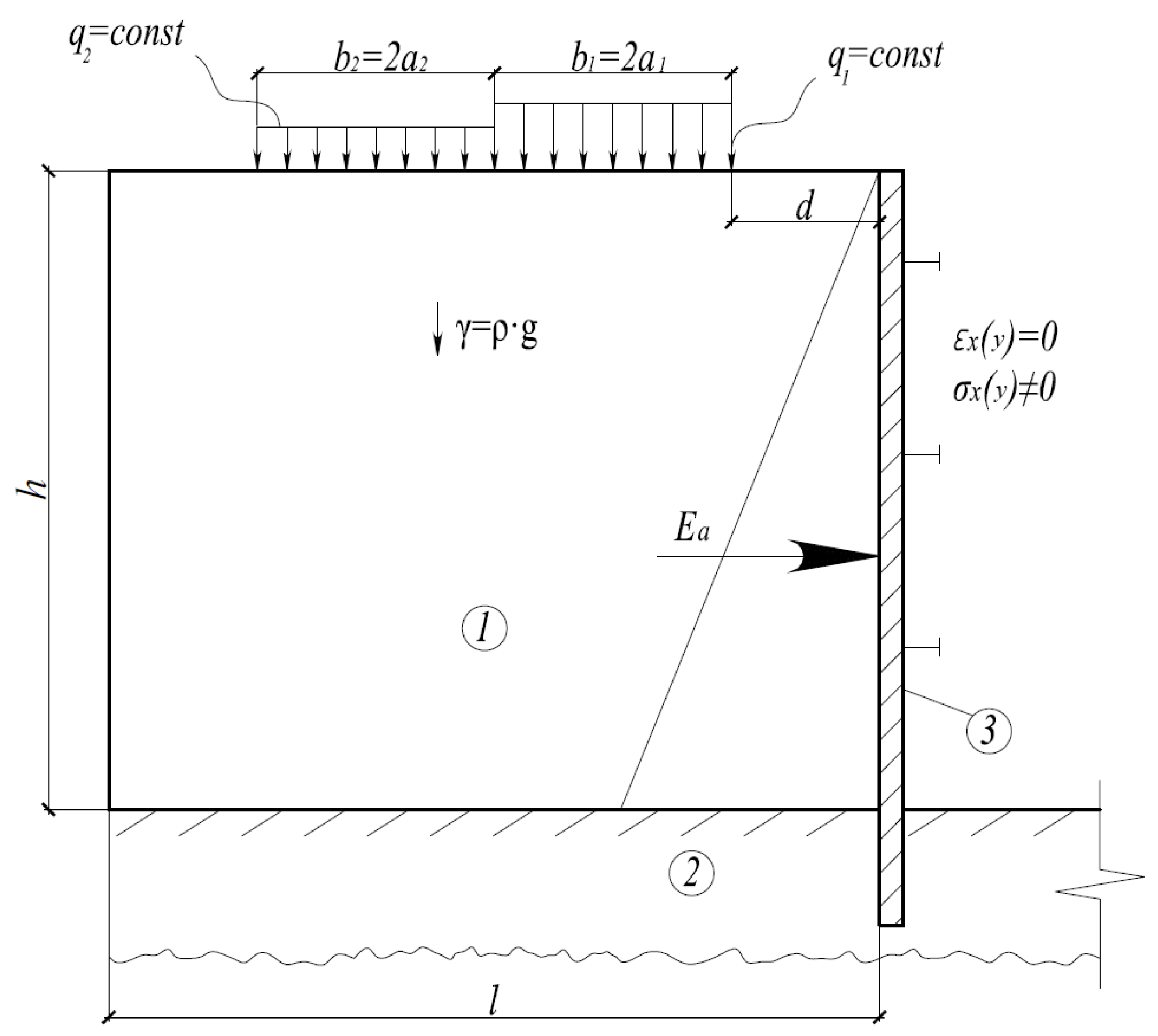
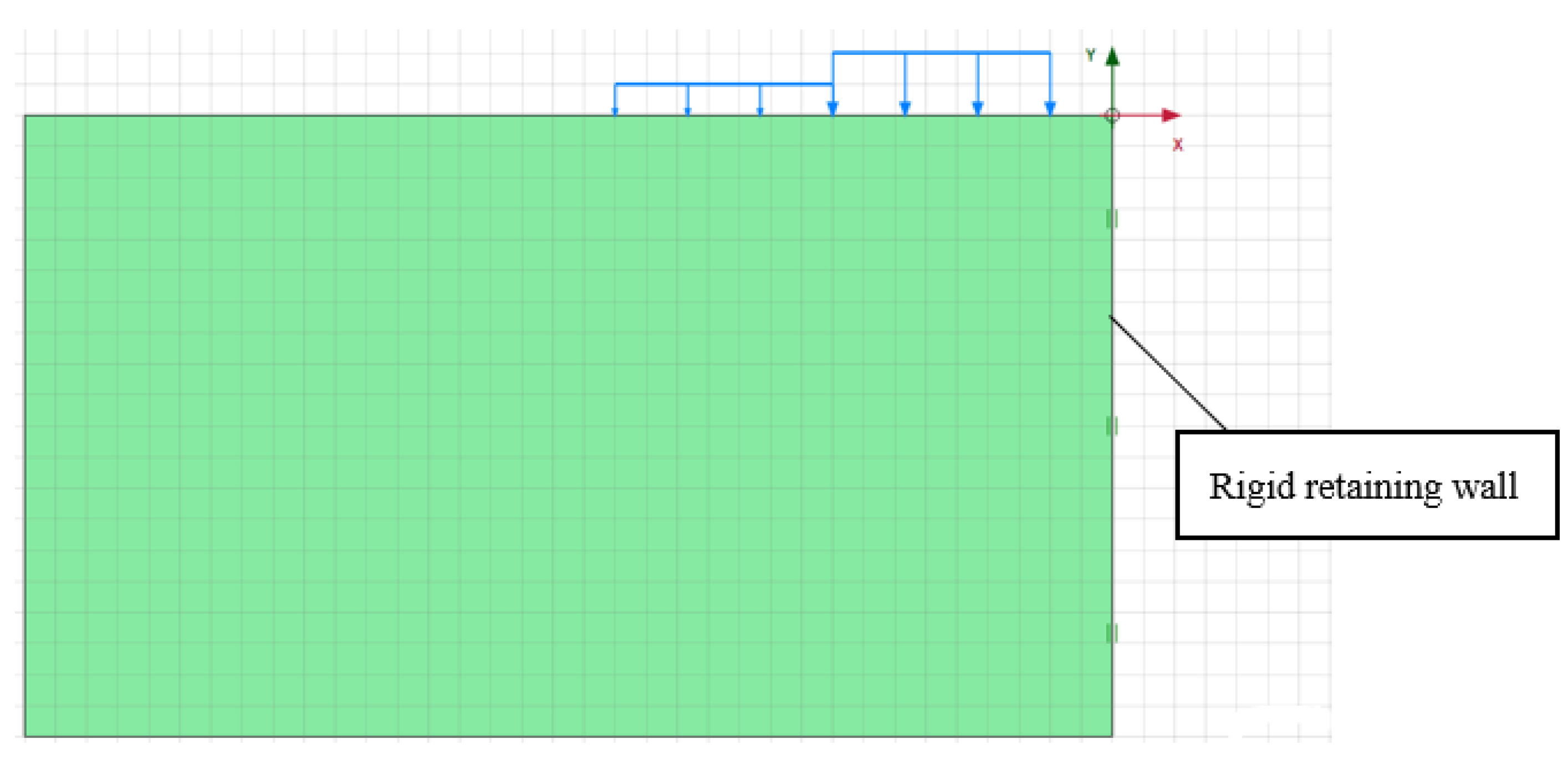
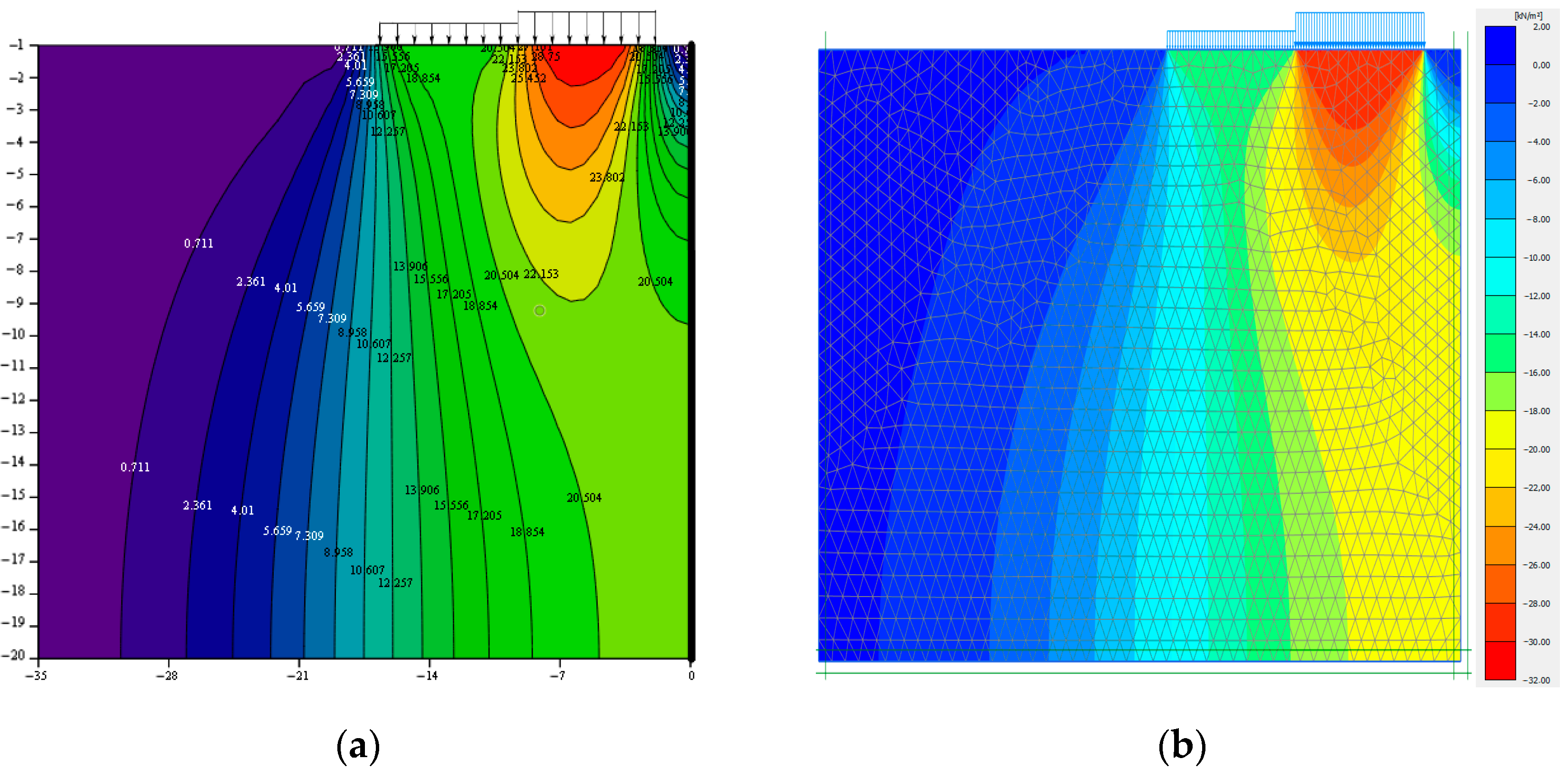
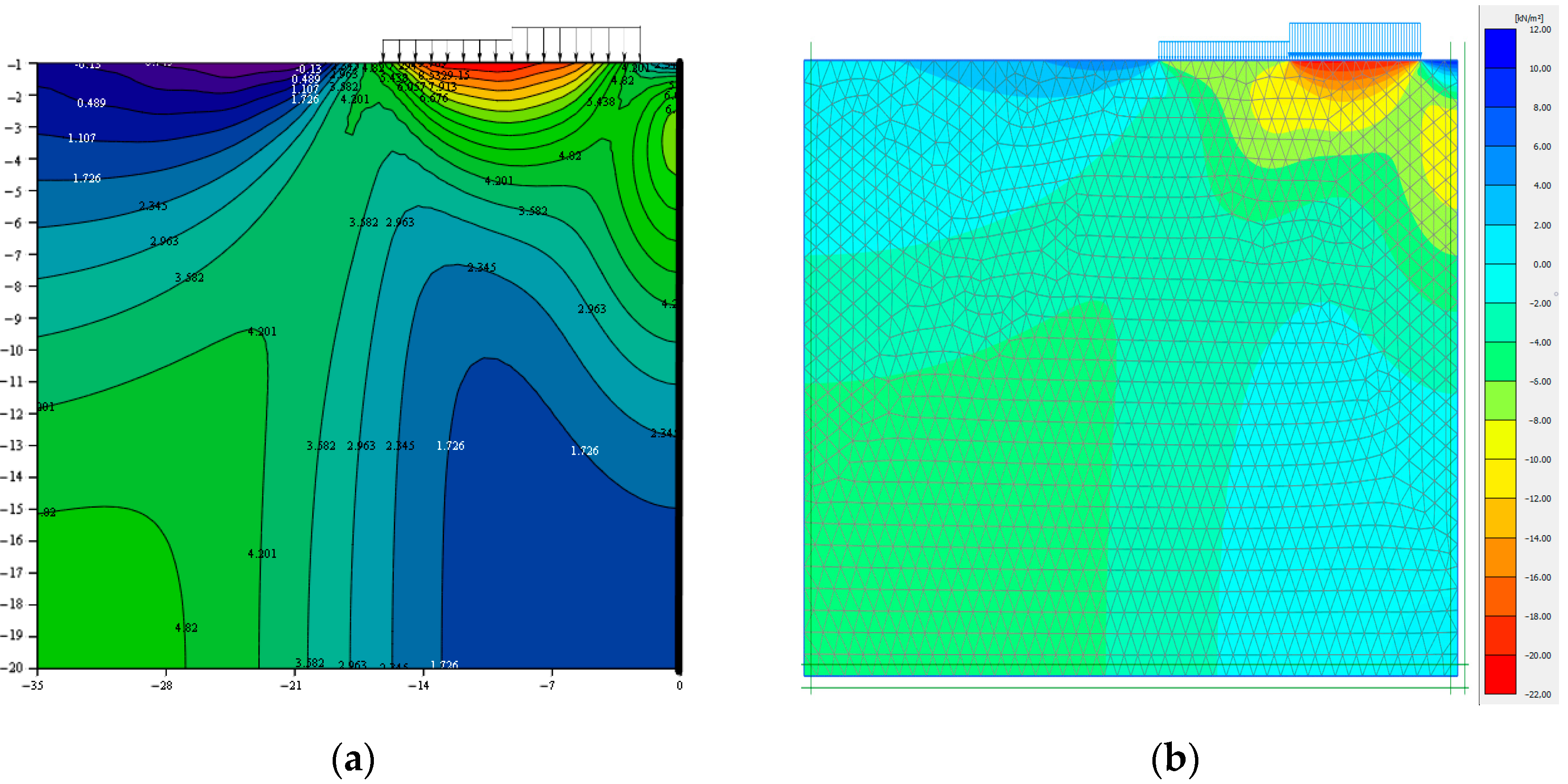
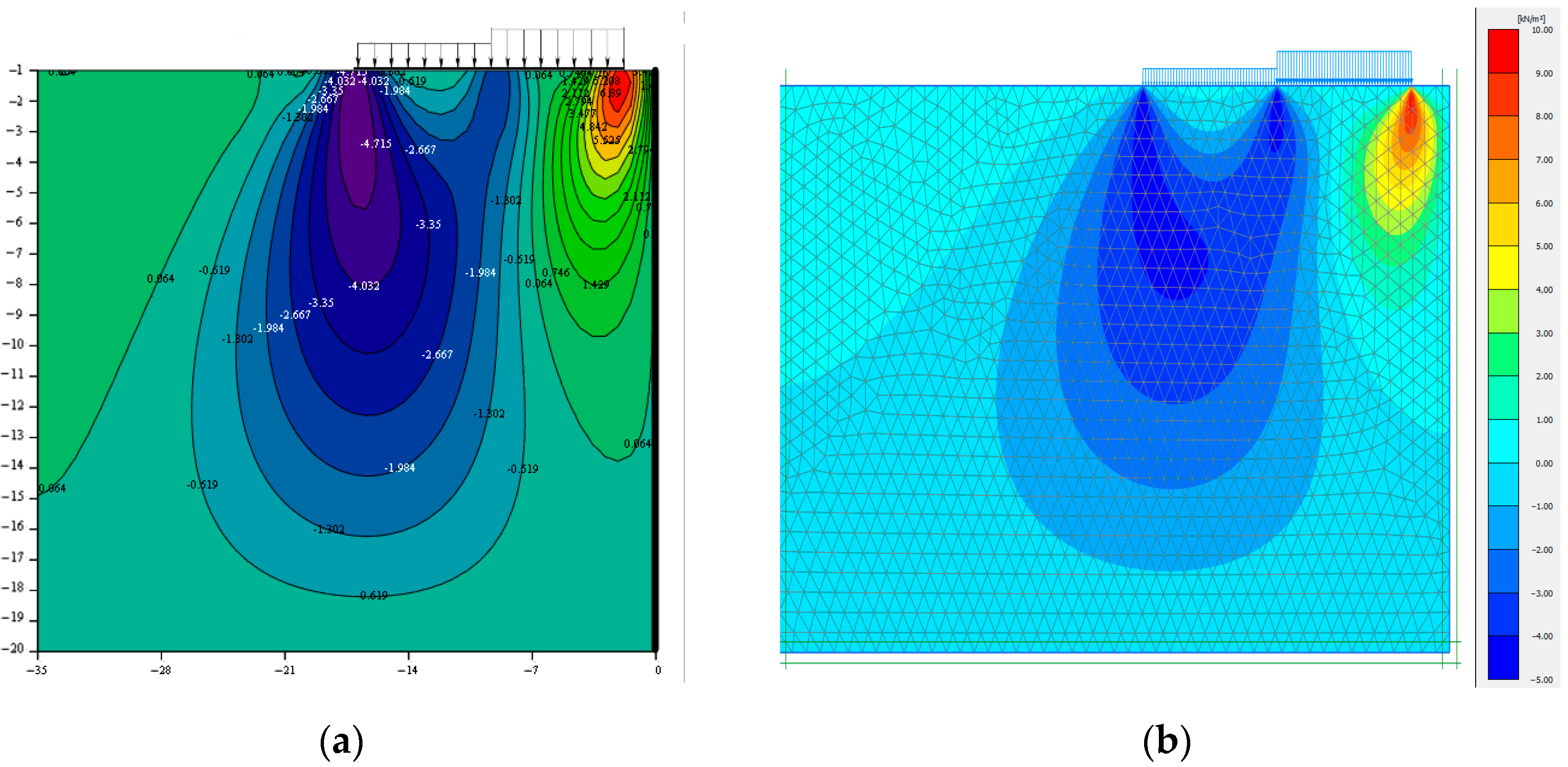
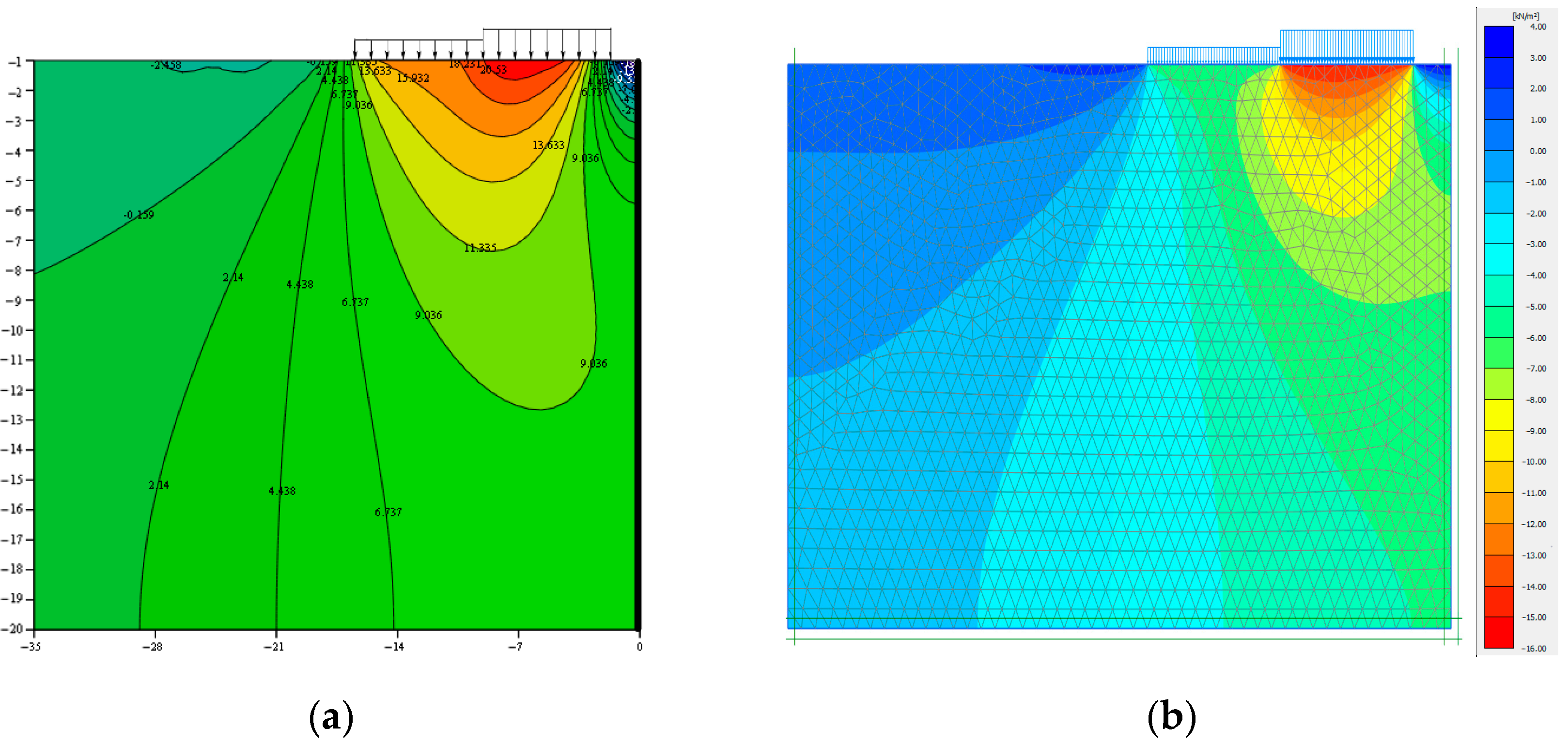
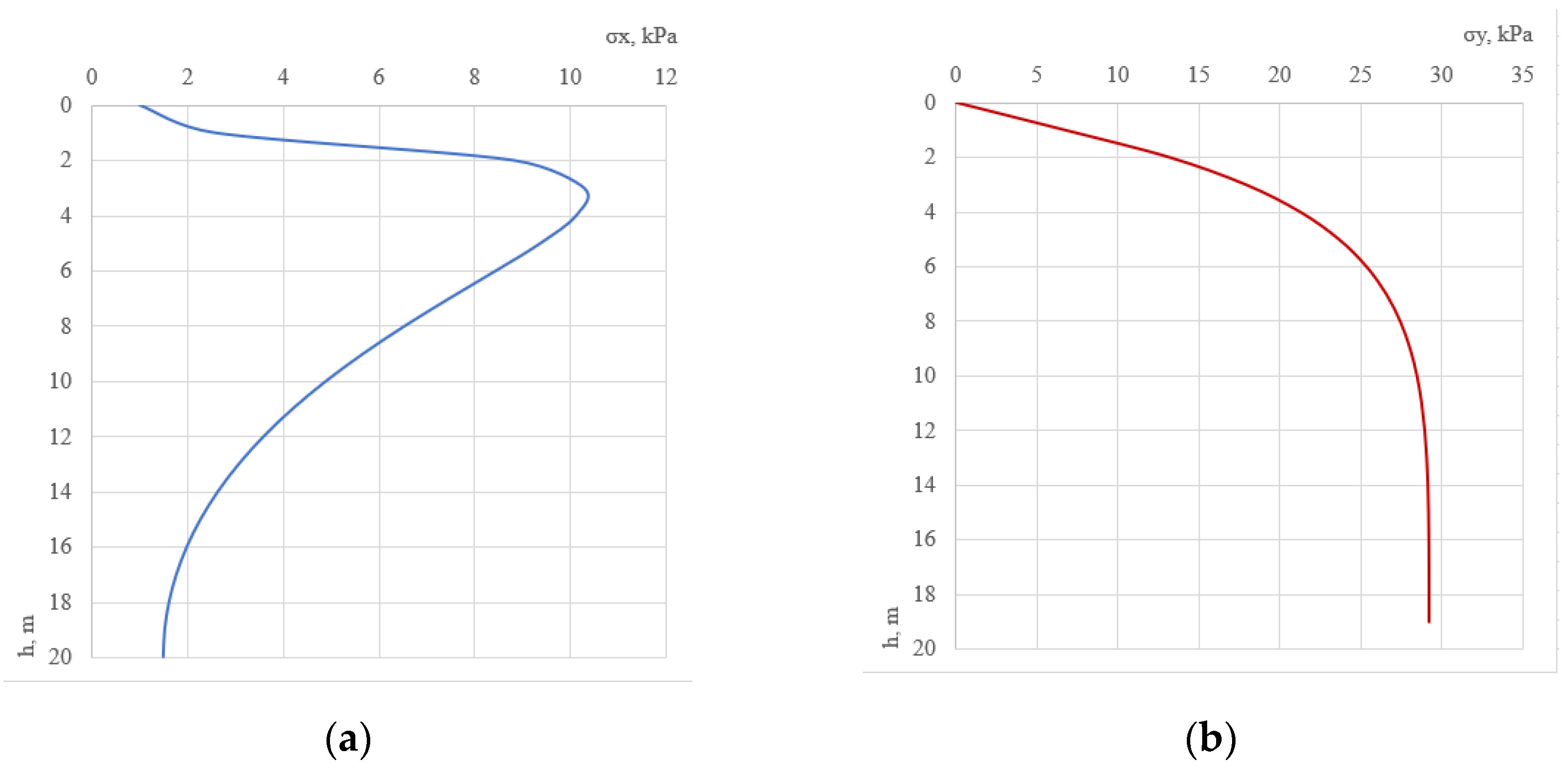
Disclaimer/Publisher’s Note: The statements, opinions and data contained in all publications are solely those of the individual author(s) and contributor(s) and not of MDPI and/or the editor(s). MDPI and/or the editor(s) disclaim responsibility for any injury to people or property resulting from any ideas, methods, instructions or products referred to in the content. |
© 2023 by the authors. Licensee MDPI, Basel, Switzerland. This article is an open access article distributed under the terms and conditions of the Creative Commons Attribution (CC BY) license (https://creativecommons.org/licenses/by/4.0/).
Share and Cite
Ter-Martirosyan, A.Z.; Vanina, Y.V. A Mathematical Analysis of the Stress Statement of the Soil Basis under Complex Loading near the Retaining Wall. Axioms 2023, 12, 536. https://doi.org/10.3390/axioms12060536
Ter-Martirosyan AZ, Vanina YV. A Mathematical Analysis of the Stress Statement of the Soil Basis under Complex Loading near the Retaining Wall. Axioms. 2023; 12(6):536. https://doi.org/10.3390/axioms12060536
Chicago/Turabian StyleTer-Martirosyan, Armen Z., and Yulia V. Vanina. 2023. "A Mathematical Analysis of the Stress Statement of the Soil Basis under Complex Loading near the Retaining Wall" Axioms 12, no. 6: 536. https://doi.org/10.3390/axioms12060536
APA StyleTer-Martirosyan, A. Z., & Vanina, Y. V. (2023). A Mathematical Analysis of the Stress Statement of the Soil Basis under Complex Loading near the Retaining Wall. Axioms, 12(6), 536. https://doi.org/10.3390/axioms12060536







